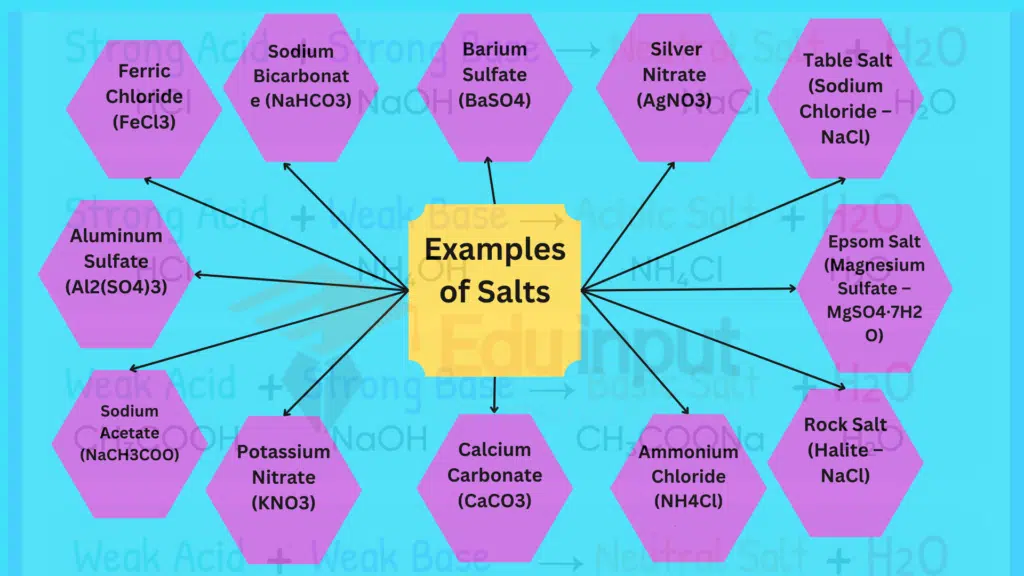20 Examples of Salts
Salts are compounds formed when acids react with bases. They consist of positively charged ions (cations) and negatively charged ions (anions) held together by ionic bonds. Salts play a crucial role in various fields, from chemistry to biology. In this article, we’ll describe 20 different examples of salts, highlighting their uses and significance.
Examples of Salts
Here are 20 Examples of Salts:

1. Table Salt (Sodium Chloride – NaCl)
Table salt, or sodium chloride (NaCl), is perhaps the most common and widely used salt. It is essential for seasoning food and is a staple in kitchens worldwide.
2. Epsom Salt (Magnesium Sulfate – MgSO4·7H2O)
Epsom salt, chemically known as magnesium sulfate heptahydrate, is a popular salt used for various purposes, including in baths for relaxation and as a magnesium supplement in gardening.
3. Rock Salt (Halite – NaCl)
Rock salt, or halite, is a naturally occurring mineral and a significant source of sodium chloride. It is often used in de-icing roads during winter.
4. Common Baking Soda (Sodium Bicarbonate – NaHCO3)
Baking soda, or sodium bicarbonate, is a versatile salt used in baking to leaven dough and in cleaning due to its mild abrasive properties.
5. Ammonium Chloride (NH4Cl)
Ammonium chloride is a salt commonly used in fertilizers, as a flux in preparing metals to be tin-coated, and in cough medicine.
6. Calcium Carbonate (CaCO3)
Calcium carbonate is a salt with various applications, including in the production of lime, cement, and as a dietary calcium supplement.
7. Potassium Nitrate (KNO3)
Potassium nitrate is used in the manufacturing of fireworks, as a food preservative, and historically in gunpowder.
8. Sodium Acetate (NaCH3COO)
Sodium acetate is employed in the textile industry as a fixing agent, in heating pads for warmth, and as a buffering agent in various chemical processes.
9. Aluminum Sulfate (Al2(SO4)3)
Aluminum sulfate is commonly used in water treatment to clarify drinking water and wastewater. It is also a key ingredient in some types of baking powder.
10. Sodium Citrate (Na3C6H5O7)
Sodium citrate finds use in the food industry as a buffering agent, in the medical field as an anticoagulant, and in cleaning products.
11. Ferric Chloride (FeCl3)
Ferric chloride is utilized in water treatment, as an etching agent in the production of printed circuit boards, and in the synthesis of various chemicals.
12. Sodium Bicarbonate (NaHCO3)
Apart from its role in baking, sodium bicarbonate is used as an antacid to relieve heartburn and indigestion.
13. Copper Sulfate (CuSO4·5H2O)
Copper sulfate has applications in agriculture as a fungicide, in chemistry labs for various experiments, and historically in the textile industry.
14. Barium Sulfate (BaSO4)
Barium sulfate is often used as a contrast medium in X-ray imaging and as a component in drilling fluids for oil and gas exploration.
15. Silver Nitrate (AgNO3)
Silver nitrate has applications in photography, as a cauterizing agent in medicine, and historically in the production of mirrors.
16. Sodium Chlorate (NaClO3)
Sodium chlorate is employed as a herbicide, in the bleaching of paper pulp, and in pyrotechnics.
17. Sodium Sulfate (Na2SO4)
Sodium sulfate is used in the manufacturing of textiles, detergents, and in the production of glass.
18. Strontium Chloride (SrCl2)
Strontium chloride is used in pyrotechnics to produce red flame colors and in toothpaste for desensitizing teeth.
19. Zinc Sulfate (ZnSO4·7H2O)
Zinc sulfate is employed as a dietary supplement, in the production of rayon, and in the prevention of moss growth on roofs.
20. Lithium Carbonate (Li2CO3)
Lithium carbonate is a crucial compound in the production of lithium-ion batteries, and it is also used in the treatment of bipolar disorder.



Leave a Reply